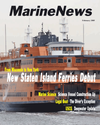
Page 30: of Marine News Magazine (February 2005)
Read this page in Pdf, Flash or Html5 edition of February 2005 Marine News Magazine
designated temperature, but as naval architecture and marine engineering, a form designed for motion. In general these are the shipyard workers, who in the case of the Molinaris assembled a struc- ture of grace and beauty. To an eye accus- tomed to the hard chines of other modern craft, the Molinaris' hulls are a surprise and a treat for their rounded lines and flowing contours. They have two pro- pellers, but are single-screw hulls, with the grace of their tapers on both ends.
Where the requirements of the upper works produce a flat-sided block, the requirements of the bottom produce sculpture.
But it was all in homage to practicality.
The boats have a 30-minute schedule on a 25 minute run, during which a couple thousand pedestrians may board, bide their time, then rush off to their appoint- ments. The broad doorways and aisles help see to that goal. Meanwhile, it's more than five miles from Point A to B on the
Molinaris' route, and the boats bustle along at some 18 miles per hour. Can they do so without rocking the barges they pass? For the most part they have in the
Staten Island service, but their hulls must be designed with that in mind. The Moli- naris' success on this score will be ren- dered by, among others, the crews of the next 35 years of tugboats.
If they are good harbor neighbors, able to refrain from swamping sailboats, their owners, the riders, will surely approve.
But it will be with a shrug, for these riders almost by definition are landlubbers, whose most pressing concerns are upland.
One of them centers on the tax office, where the price of ferry operations is col- lected. On a municipal transit system that charges no fare, this is where the public pays for the ride, and they'd like it to be as little as possible. "We wanted to get the speed, but we also wanted fuel efficiency," said Allen
Chin of the design firm of George G.
Sharp, Inc., an objective even more important for the world these boats sail into than the one for which they were planned. Where hard-edged hulls are said to gain speed through brute power, and make a bit of a wave, "sleek lines give less resistance. We purposely did it because we didn't want to waste fuel."
Looking at the Molinaris alongside the
Barberis, it's hard to believe they come from the same designers. Could two municipal ferryboats be more the oppo- site? The Barberis, known widely within ferry circles, and somewhat disparagingly, as the "buses," are completely flat sided, with no exterior deck for their riders' diversion. The open platforms at each end are merely concessions to the fact that the cabins must end somewhere. The Moli- naris, by contrast, have the most open deckspace in the history of the run - the first to offer outdoor observation on three decks at each end, plus a broad open swath on the Promenade deck, three levels above the water.
To top it all off, the Hurricane deck, the uppermost, the one with the wheelhouses upon it, for the first time has a passenger cabin too - and was designed with the idea that ferryboat riders enjoy not only the wind in their faces and the water below, but the stars overhead as well.
If this study in opposites suggests any- thing, it's that professional, disciplined designers know how to interpret their mandates, and execute their instructions. 30 • MarineNews • February, 2005
Staten Island Ferry
Name Captain Greg Hanchrow
Title Director of Marine
Operations
Company Spirit City Cruises
Web www.spiritcitycruises.com
Fleet size: Spirit Cruises, LLC operates a fleet of 13 vessels in seven of America's most popular port cities, including
Boston, Chicago, New York and Weehawken, NJ (New York
Harbor), Norfolk, Philadelphia, and Washington, D.C. “When
I look for new marine equipment, I refer to
Maritime
Reporter”
Captain Greg Hanchrow
Director of Marine Operations
Spirit City Cruises
New York, NY
Circle 241 on Reader Service Card
MN FEB05 (25-33).qxd 1/26/2005 5:04 PM Page 30

 29
29

 31
31
